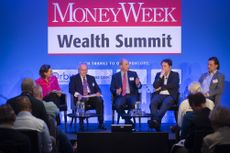How will we repay our vast debt pile? Do we even need to?
In his recent articles looking at different aspects of the fixed-income investing world, David Stevenson looked at inflation. Today he looks at a closely related concept – government debt.

Investors and politicians have been worrying about government debt for decades. In the 1990s, “debt clocks” – which showed just how just much that mountain of debt was increasing every second – became extremely popular, with some clocks in the US displayed on the side of buildings.
The not-so-subtle message? It’s only going one way: upwards! And it did. The question now is: how will we pay it back? And how might that affect investors’ pockets?
Our debts are only going to get even bigger
Back at the start of the 2000s, we were worrying about aggregate UK government debt hitting the £500bn mark (which happened in 2007). According to government statisticians, it’s currently standing at just over £2trn and is likely to head significantly higher in the coming months.
Subscribe to MoneyWeek
Subscribe to MoneyWeek today and get your first six magazine issues absolutely FREE

Sign up to Money Morning
Don't miss the latest investment and personal finances news, market analysis, plus money-saving tips with our free twice-daily newsletter
Don't miss the latest investment and personal finances news, market analysis, plus money-saving tips with our free twice-daily newsletter
As that number has inexorably climbed, a related concern has emerged: who’s buying that extra debt? The answer is that a growing proportion is ending up on the balance sheet of the Bank of England. And strategists at investment bank Jefferies have suggested that the central bank will end up backing the vast majority of government deficit financing.
The pandemic isn’t entirely to blame for this state of affairs. For the last decade, central banks across the globe have been boosting their balance sheets by buying securities including corporate bonds, exchange-traded funds, and government bonds. This so-called quantitative easing (QE) has merely intensified in the Covid era.
Researchers at CrossBorder Capital have suggested that the huge monetisation of deficits planned by central banks will see the size of their balance sheets jump by a third, potentially resulting in “15%-20% monetary growth in 2020” which in turn “surely must lead to faster inflation of circa 5%-10% in the US from 2021”.
At this point, many economists suggest we should stop worrying. Monetarists might worry about future inflation (due to too much cash chasing too few goods and services), but those influenced by eminent economist John Maynard Keynes’s views argue that this is all to be expected – and encouraged.
If we are to avoid deflation and a “doom loop” whereby falling demand leads to higher unemployment which in turn weakens demand further, they say, then the government must step in and spend during periods when consumers and companies are cutting back and trying to boost savings.
If deficits rise but growth picks up, the government will benefit from a higher tax take, which should help balance the books. And if all else fails, increased inflation can help depreciate the real value of all those debts.
The rise of Modern Monetary Theory (MMT)
Even many classic Keynesians accept that there must be a limit to this deficit-fuelled expansion. But ongoing subpar growth and low inflation in recent years has emboldened a new, radical breed of economists, with a new set of proposals.
They suggest that governments can print money almost without limit (bar rampant inflation) and can thus innovate with new ideas such as sending government cheques direct to taxpayers (as the US government has already done).
This radical school of thinking even has its own term – modern monetary theory (MMT). One of its foremost proponents is Stephanie Kelton, a professor of economics at Stony Brook University and senior economic adviser to Bernie Sanders’s presidential campaign.
She and other MMT-ers argue that a government which can issue its own currency need never default, since it can always print pounds or dollars to repay gilts or Treasuries, say. So the only real limit to government spending is not the deficit, but inflation.
In the absence of inflation, what could all that extra government debt be used to fund? In Kelton’s recent bestseller, “The Deficit Myth”, she argues for a “people’s economy” which includes a Green New Deal; a guaranteed job for everyone; free healthcare; free childcare; the immediate cancellation of student debt; free college; “affordable housing for all our people”; national high-speed rail; “expanded social security”; “a more robust public retirement system”; and “middle-class tax cuts”.
Kelton’s ideas are at the more radical end of academic opinion, but many central banks have already experimented with radical ideas based on quantitative easing (QE) – for example, in Japan and the US, central banks have already been buying funds containing stocks and junk bonds.
Helicopter drops of money to consumers using central-bank-controlled “e-money” accounts with all citizens are also being openly discussed in policy circles.
So while we may not end up with MMT, we may see more and more radical plans to print money to spend and give away. In those circumstances, worries about inflation from rampant monetary growth aren’t completely unfounded. Indeed, it may seem like an obvious outcome.
However, it is worth noting that the country that has thus far been most closely associated with radical monetary policy – Japan – is also more readily associated with deflation, rather than inflation.
And the fact that we are even discussing a once-outlandish theory such as MMT so openly today stems precisely from the difficulties that central banks have encountered in generating sustainable inflation.
So while it’s certainly an issue to watch, it’s perhaps also wise to be wary of taking an inflationary future for granted.

David Stevenson has been writing the Financial Times Adventurous Investor column for nearly 15 years and is also a regular columnist for Citywire.
He writes his own widely read Adventurous Investor SubStack newsletter at davidstevenson.substack.com
David has also had a successful career as a media entrepreneur setting up the big European fintech news and event outfit www.altfi.com as well as www.etfstream.com in the asset management space.
Before that, he was a founding partner in the Rocket Science Group, a successful corporate comms business.
David has also written a number of books on investing, funds, ETFs, and stock picking and is currently a non-executive director on a number of stockmarket-listed funds including Gresham House Energy Storage and the Aurora Investment Trust.
In what remains of his spare time he is a presiding justice on the Southampton magistrates bench.
-
 What is bitcoin halving and what does it mean for crypto investors?
What is bitcoin halving and what does it mean for crypto investors?Bitcoin halving is likely to take place this week, according to experts. Historically, this practice has caused the cryptocurrency to soar in value. But will this time be different?
By Katie Williams Published
-
 British Airways revamps Avios scheme bringing down flight prices to £1
British Airways revamps Avios scheme bringing down flight prices to £1With the new Avios part-payments scheme you can now bag a British Airways flight for as little as £1
By Oojal Dhanjal Published
-
 Halifax: House price slump continues as prices slide for the sixth consecutive month
Halifax: House price slump continues as prices slide for the sixth consecutive monthUK house prices fell again in September as buyers returned, but the slowdown was not as fast as anticipated, latest Halifax data shows. Where are house prices falling the most?
By Kalpana Fitzpatrick Published
-
 Rents hit a record high - but is the opportunity for buy-to-let investors still strong?
Rents hit a record high - but is the opportunity for buy-to-let investors still strong?UK rent prices have hit a record high with the average hitting over £1,200 a month says Rightmove. Are there still opportunities in buy-to-let?
By Marc Shoffman Published
-
 Pension savers turn to gold investments
Pension savers turn to gold investmentsInvestors are racing to buy gold to protect their pensions from a stock market correction and high inflation, experts say
By Ruth Emery Published
-
 Where to find the best returns from student accommodation
Where to find the best returns from student accommodationStudent accommodation can be a lucrative investment if you know where to look.
By Marc Shoffman Published
-
 Best investing apps
Best investing appsWe round up the best investing apps. Looking for an easy-to-use app to help you start investing, keep track of your portfolio or make trades on the go?
By Ruth Emery Last updated
-
 The world’s best bargain stocks
The world’s best bargain stocksSearching for bargain stocks with Alec Cutler of the Orbis Global Balanced Fund, who tells Andrew Van Sickle which sectors are being overlooked.
By Andrew Van Sickle Published
-
 Revealed: the cheapest cities to own a home in Britain
Revealed: the cheapest cities to own a home in BritainNew research reveals the cheapest cities to own a home, taking account of mortgage payments, utility bills and council tax
By Ruth Emery Published
-
 UK recession: How to protect your portfolio
UK recession: How to protect your portfolioAs the UK recession is confirmed, we look at ways to protect your wealth.
By Henry Sandercock Last updated